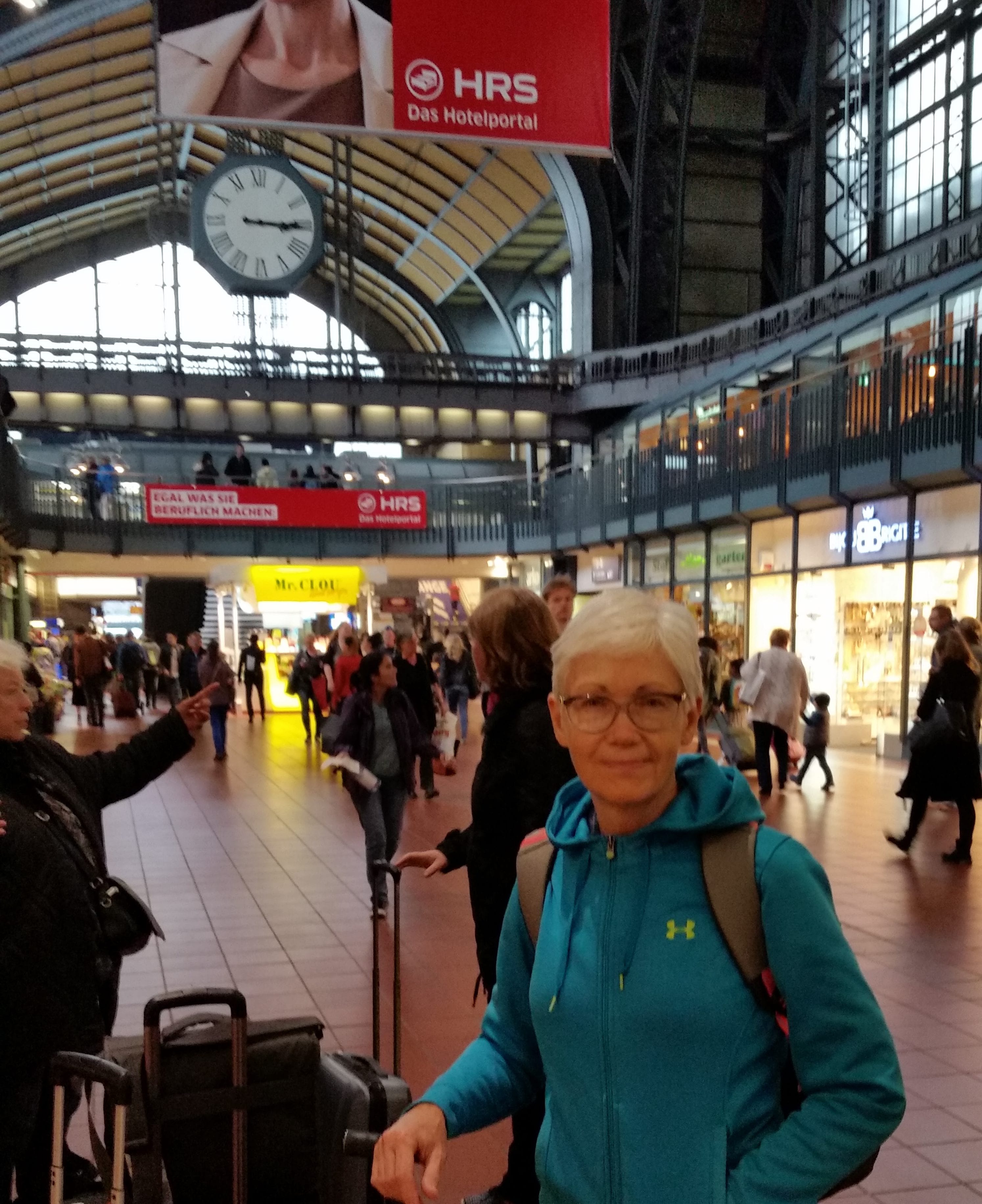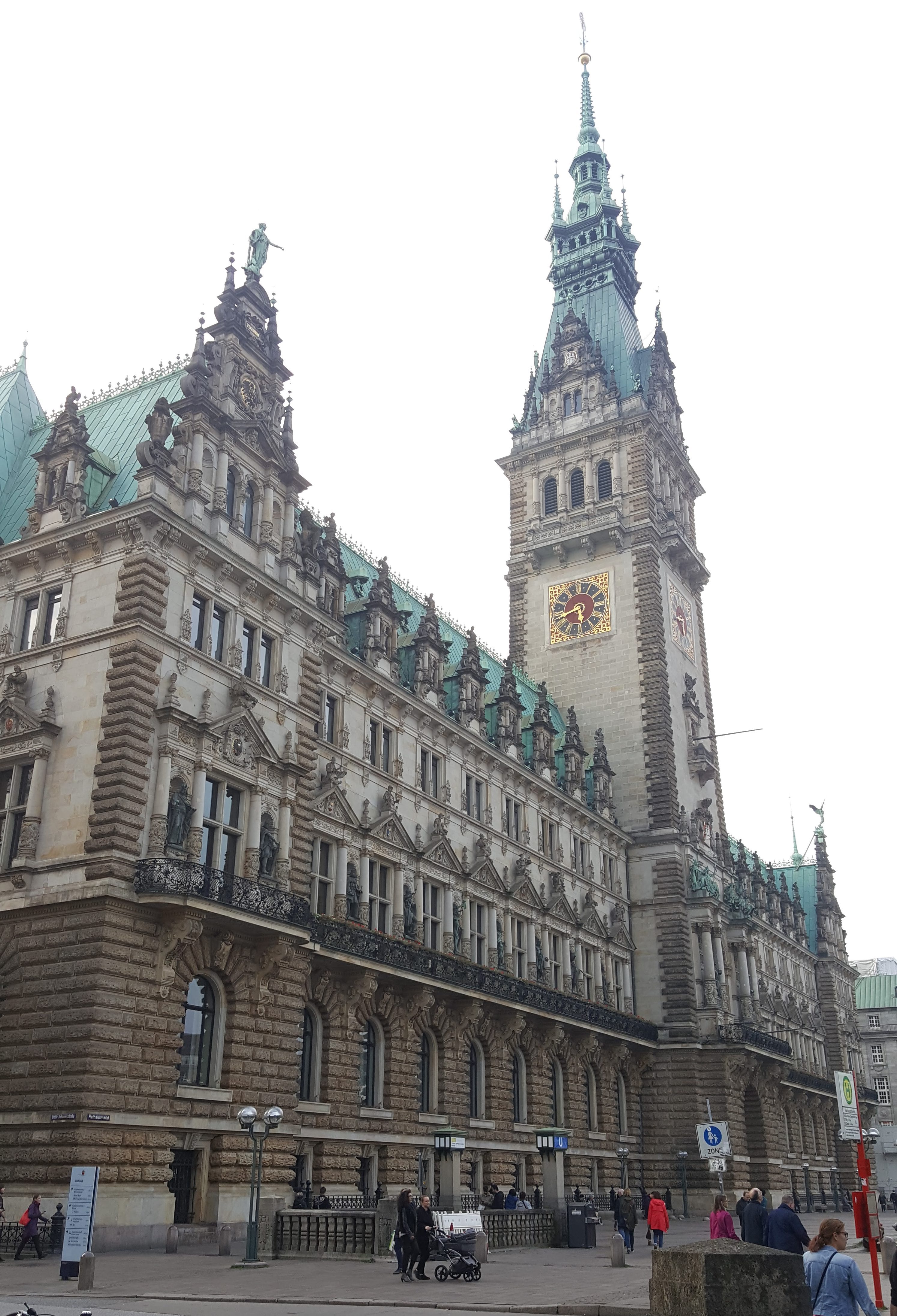
Packing
Now that we are veterans of several overseas journeys, packing has become a lot easier. However, anticipating what we would need for this trip presented some unique challenges. Today we did not need to worry about protecting the rest of the items in our luggage from dusty hiking boots and trekking poles, but rather about protecting our dress shoes from scuffing and preventing wrinkles in our semi-formal wear. Michael had determined that he would need neither a tux nor a tie for the gala opening week at the Berlin Staatsoper, but he did need a nice jacket, and Nancy felt obliged to take along some fancier dresses and accessories than she usually packs.
Delta’s daily direct flight from Cincinnati to Paris leaves at 6:16 p.m. and arrives at 8:30 a.m. Nancy hoped that reading a little, writing a little, and then watching The Immortal Life of Henrietta Lacks (which did justice to the book) would help her wind down and nod off. Michael hoped that watching A Dog’s Purpose and Dr. Strange would do the same, but nothing worked. Both of us spent a sleepless night.
Even though our flight had left Cincinnati later than scheduled due to some delay in prepping the plane, we arrived in Paris early. Not terribly early, but enough that we had to sit on the tarmac for thirty minutes before our gate was vacated by its previous occupant. So much for arriving ahead of schedule.
Because the last time we had flown through Charles de Gaulle (on our trip to Greece in May) we had barely made it onto our connecting flight even with a two-hour layover, this time we had given ourselves a four-hour cushion. Naturellement, today the Parisians had their act together. We breezed through immigration and security checks with plenty of time to spare, which gave us a chance to get some lunch. Neither of us was very hungry because a light breakfast had been served on the plane shortly before we landed, but we decided to get a little something because we probably wouldn’t have a chance to eat anything more than airline snacks until mid-afternoon. Michael found a kiosk offering “frais, biologique” fare and brought some carrot soup back to Nancy, who had fired up her laptop so she could continue writing. The soup fulfilled our modest needs but was a little disappointing, considering that we were in the capital of haute cuisine. We also were disappointed that the terminal where we had to wait for our flight to Hamburg was not furnished with the comfortable lounge chairs we had found in other terminals at CDG. So, compelled to sit erect, Nancy continued writing while Michael contented himself with people-watching.
The first thing he noticed was that among those waiting to board the Air France flight to Hamburg, we were the only ones not speaking German. Michael is still taken by surprise when reminded that people actually do speak German, and that it is not just an academic language to be studied in high school.
When it came time to board, the German passengers–true to their stereotype–did so in an orderly fashion, and demonstrated marvelous patience while others struggled to fit their luggage into the overhead bins. Germans appear to be as well-equipped and tech-savvy as their North American counterparts–no surprise. The young Millennial who sat down next to us immediately plugged in his laptop and started watching an episode of Game of Thrones.

Nancy boards our flight from Paris to Hamburg
We didn’t expect meal service because the flight was short, but the flight attendants did hand out packages containing small sandwiches: shredded carrots and zucchini mixed with fromage frais on whole wheat bread, which was just enough to keep us going until the Central Europe Time Zone’s dinner hour.
The Hamburg Airport, named after former German chancellor Helmut Schmidt, is undergoing major renovation and apparently has few if any functioning jetway gates. We deboarded onto the tarmac, where buses arrived to transport us to the terminal. After gathering our bags, we headed toward the door marked “Nothing to Declare” and were amazed to find that it led directly to ground transportation: no immigration check at all. Pretty easy to enter Germany if you’re flying in from Paris–and disappointing if you were hoping to get another stamp in your passport.

A high-speed train makes the trip from the airport into central Hamburg easy
This being Europe and not the U.S., we expected that taking a train from the airport to the Hauptbanhof (train station) in Hamburg’s Altstadt area would be easy, reliable, and safe–expectations that were fully met. Why won’t more Americans encourage their local governments to provide the same kind of efficient, integrated public transportation systems that Europeans have?

The Hamburg Hauptbanhof

Inside Hamburg’s Hauptbanhof
Once we arrived at the Hauptbanhof, we noted the location of the car rental agency we would need to find in the morning and emerged onto the street. Using the GPS on our phones (we used to take such pride in our ability to read a map!), we oriented ourselves and then started towing our luggage toward the Hotel Barceló a few blocks away. Michael had intended to push on without resting until after dinner, but once we got into our room, Nancy insisted on taking a nap. This worried Michael because Nancy doesn’t do short naps, but after an hour, she was ready to go. Michael admits that he didn’t mind closing his eyes for about thirty minutes, too.
Sunset was still a couple of hours off. We walked back toward Mönckebergstrasse, a major pedestrian thoroughfare that runs more than a mile through central Hamburg from the train station to the rathaus (town hall). Retail stores (H&M, Zara, Michael Kors, Coach–the usual lineup) stand along both sides of the street, while a conglomeration of kiosks and café tents occupy the space in the middle. At first we thought the crowds gathered around seasonal biergärtens must be reveling tourists, but we soon realized that nearly everyone we passed was speaking German. Mönckebergstrasse was alive with shoppers, families heading home after a day’s outing, and couples enjoying the music and the street food: thousands of Hamburgers simply taking advantage of a beautiful autumn evening. We were delighted to be among them.

A young cellist performs in front of a monument to Johann Georg Mönckeberg, Hamburg’s first mayor. The small building behind the monument is nominally a museum, but it seems to be occupied mostly by a Starbucks
The shopping district along Mönckebergstrasse ends with a big, modern, indoor mall on one side of the street and the huge Hauptkirche St. Petri (Church of St. Peter) on the other.

Hauptkirche St. Petri. The massive tower was completed in 1878
The first St. Peter’s on the site was a Catholic cathedral, built about 1190. Over the next couple of centuries it was rebuilt in grander style, and after the Reformation, ownership of the cathedral transferred to the Evangelical Lutheran Church. By the beginning of the nineteenth century, the building had fallen into such a state of disrepair that Napoleon’s soldiers felt no compunction about using it for a stable–and to imprison Hamburgers who refused to provide them with food. Following that episode, the whole building was demolished and rebuilt, only to become victim to a devastating fire in 1842. The current structure dates from about 1850.

This door handle and its mate, rare remnants of the 14th-century iteration of Die Hauptkirche St. Petri, are said to be the oldest artworks in Hamburg

Looking across the Rathausmarkt back toward St. Petri
A few blocks beyond St. Peter’s Church we came to the Rathaus. the seat of the senate and parliament of “The Free and Hanseatic City of Hamburg.” The old city hall burned down in the same fire that destroyed St. Peter’s, but nearly fifty years passed before the civic building was replaced. Visiting hours were over by the time we arrived, so we couldn’t go inside.

The Rathaus of the Free and Hanseatic City of Hamburg

Rathaus entrance gate

The Creation panel on the pulpit steps in St. Katharinen Kirche

Noah’s Ark panel from the pulpit steps
We did go inside the Church of St. Katharine, drawn by its picturesque tower–whose thirteenth-century base is the second-oldest structure in Hamburg. The unexpectedly light, whitewashed interior of the current building (completed in 1957) includes lovely examples of twentieth-century woodcarving on the pulpit and the ends of each pew. Most notable, however, is St. Katharine’s historic organ, which may have been the largest in the world during the eighteenth century. Along with the church, the organ was heavily damaged by bombing during World War II, but many of the old pipes and stops were saved and thus provided the base for a meticulous restoration, which was completed only a few years ago. Just as we were about to leave, we saw someone mount the stairs to the loft and heard him play a few warm-up scales, but then the instrument went silent–alas.

St. Katharinen Kirche interior and organ

The spire of St. Katharinen Kirche towers over the Elbe. The newly opened Elbphilharmonie concert hall is visible in the distance

Pleasure boats abound in Alster Lake, which was created in central Hamburg where the Alster River converges with the Elbe
St. Katharine’s is situated on a bank of the Elbe River and for centuries has served as the spiritual home of Hamburg’s seamen. Although Hamburg is more than fifty kilometers from where the Elbe meets the North Sea, it is nevertheless a port city, crisscrossed with as many narrow waterways as streets. We walked along some of the city’s quays as far as we could toward the Elbphilharmonie–Hamburg’s brand-new concert hall–until we had to turn around and go back to the Altstadt area, where we had a 7:00 dinner reservation.
Having learned to appreciate haute cuisine while on his mission in France, Michael has retained something of the French horror of German cooking. (A few months ago, when Nancy suggested trying a restaurant that Cincinnati magazine had described as having “great German food,” Michael retorted: “Is there such a thing?”) Therefore, Nancy was not surprised that Michael had chosen to reserve a table at a tapas place called Picasso rather than at, say, Alt Hamburger Aalspeicher (Old Hamburg Eel Tank). The choice was an excellent one not only because the food was marvelous, but also because the menu was written in Spanish as well as German, so Nancy was able to figure out which dishes we should order even though the waiter was unable to provide any English translation. (We had supposed that most Germans would have learned English in school, but we hadn’t considered the idea that a lot of service workers would be non-English-speaking immigrants.)

Restaurante Picasso
As we happily emptied our first basket of crusty bread (served with good aioli and Spanish olives) while waiting for our tapas plates to start arriving, we noticed that the entire party of four seated at an adjacent table had gotten up from their chairs and walked out, leaving all their plates and wine glasses more than half full. They didn’t seem to have finished eating, and no one came to clear their table even though the area near the front door was crowded with people waiting for seats, so we were puzzled. Why had they left? About five minutes later the whole group returned and resumed eating as if nothing unusual had happened. When this scenario was repeated about twenty minutes later, we realized what was going on: the diners had gone outside to smoke. We had noticed a lot more tobacco use on the streets of Hamburg this afternoon than we normally see anywhere in the States, but apparently it is verbotten to smoke indoors.

Tapas at Picasso
But back to the food. The tapas we shared tonight included grilled lamb chops served with a balsamic vinegar reduction and roasted baby potatoes, ham croquettes (much tastier than the notorious “bloops” served at the Madrid Residencia where Nancy spent her semester abroad), ratatouille, avocado salad, and rounds of crispy fried eggplant lightly drizzled with honey (divine!). The dessert menu contained some names that we could not figure out either in Spanish or German, and the waiter’s attempts at descriptions didn’t help a great deal, so Nancy stuck with a safe choice: Crema Castillana (a lovely molded panna cotta with a light caramel sauce). Michael took a leap of faith and ordered the Torta de Santiago/Galizischer mandelkuchen, which turned out to be a slice of almond cake decorated with spiced powdered sugar sprinkled through a stencil shaped like the Sword of Santiago (St. James), served with a scoop of vanilla ice cream. He was satisfied.
Mönckebergstrasse was just as busy after dark as it had been earlier this evening. Had we been able to sleep on the plane last night, we might have lingered longer with the crowds celebrating Oktoberfest, but tonight we felt less inclined to drink and dance than to walk back to the hotel and collapse into bed.

A fruit vendor on Mönckebergstrasse

Where else but Germany would you find a kiosk selling nothing but pickles?

The music emanating from this tent was not what one would expect from a couple of middle-aged men wearing lederhosen: closer to punk rock than polkas

Were we beer drinkers, we might have sampled all manner of ales and lagers from vendors along Mönckebergstrasse tonight
Leave A Comment